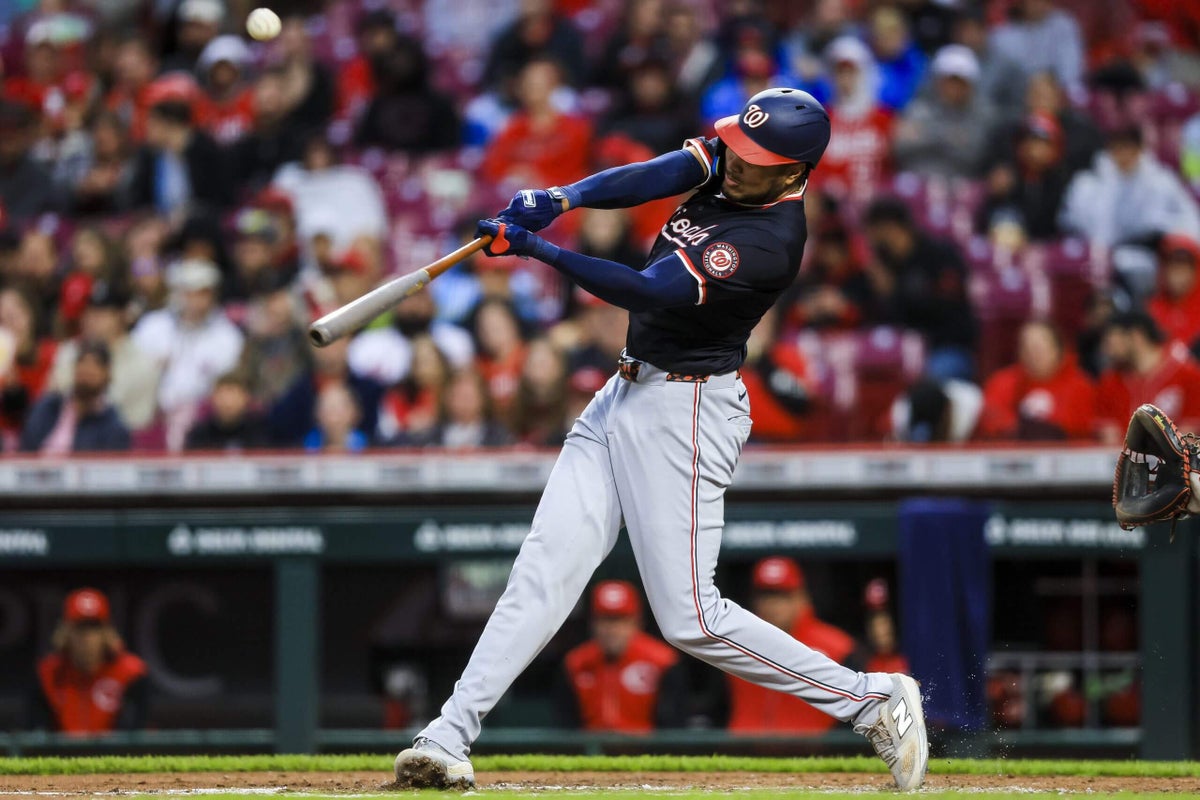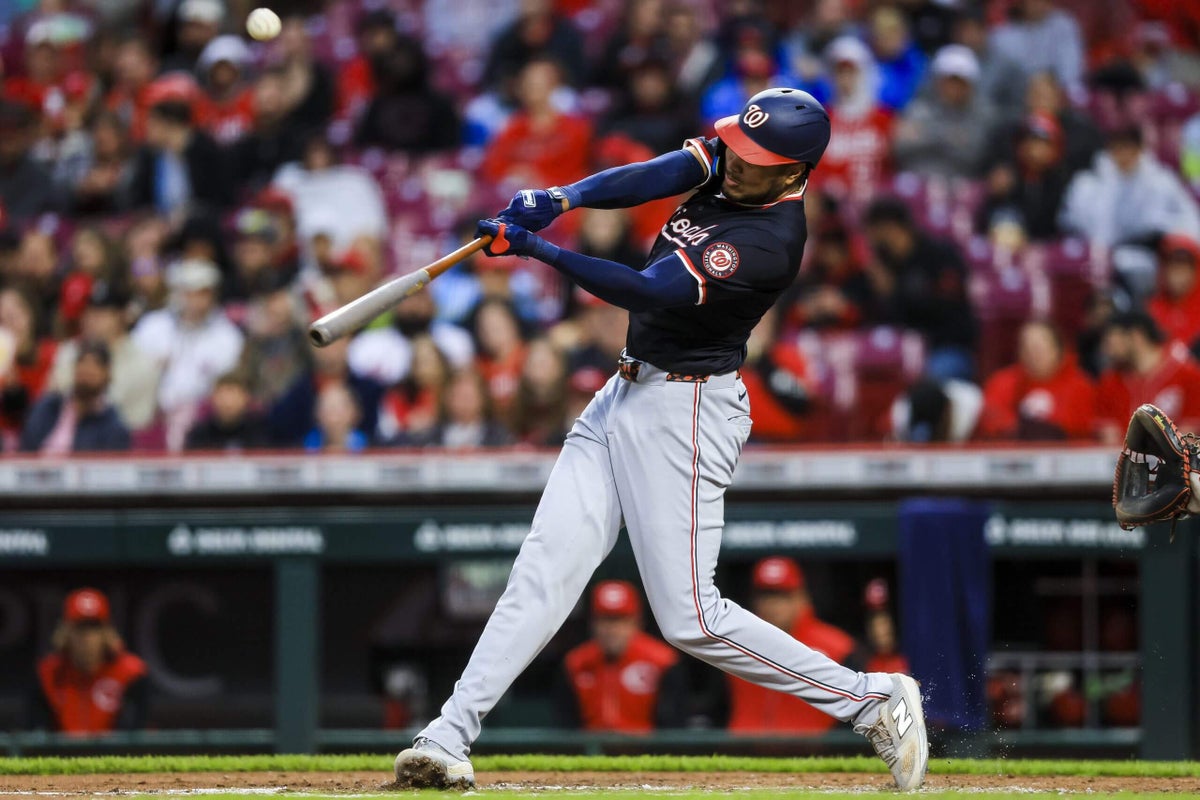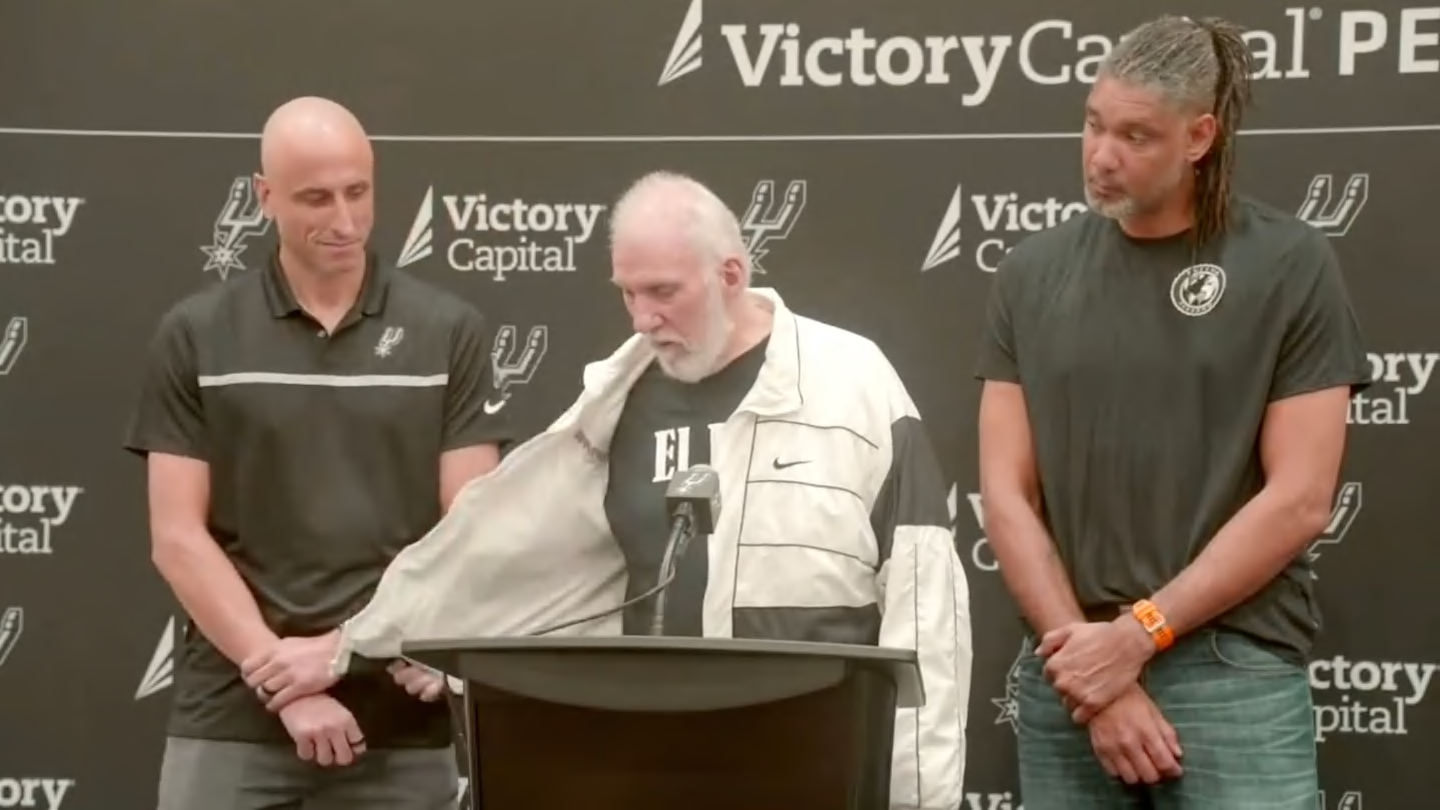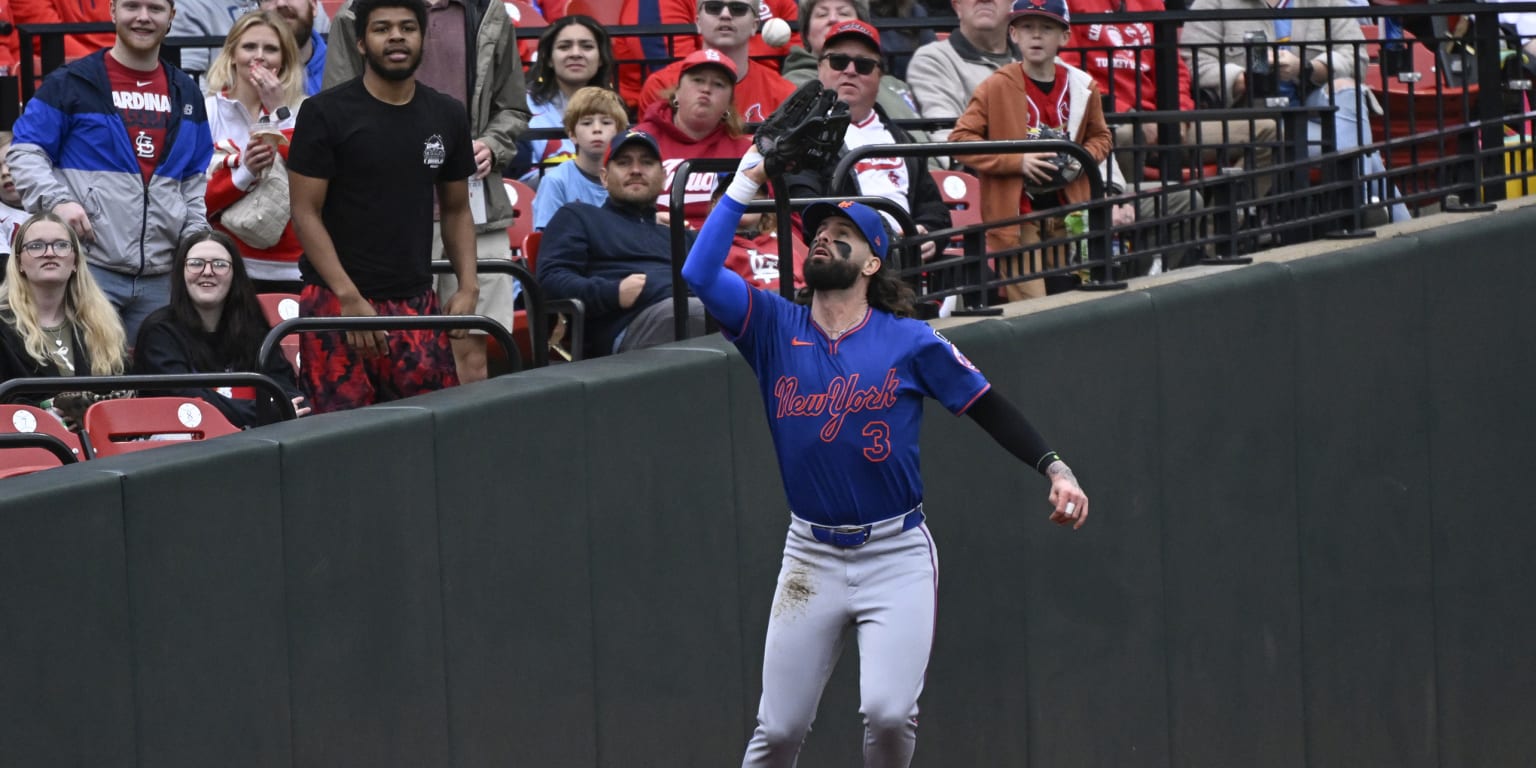
PHILADELPHIA — It’s a Wednesday afternoon in Toronto, the end of the Washington Nationals’ first road trip of the season. Ninth inning, two outs, time to pack for the airport. But James Wood has one more swing, and that is always worth watching.
The description on Statcast of what happens next is appropriately mundane: James Wood singles on a ground ball to right fielder Anthony Santander. Yet a month later, even after witnessing stupendous home runs from his precocious teammate, Nathaniel Lowe isn’t over that routine hit, and everything it signified.
Advertisement
“It didn’t make a crazy sound, it didn’t go far, it was just a single up the middle,” said Lowe, who saw it from the on-deck circle at Rogers Centre. “And I looked up at the scoreboard and it said 115 mph. And I was like, ‘I guess it’s just that casual, you know?’ Because (with) the homers, everybody looks at the board, looks at the metrics, and when the ball goes 400 feet, you pay attention to that. But just, like, a lousy single up the middle at 115 — things like that are gonna go overlooked.”
This is the time to celebrate those singles and the purity of what Wood is doing. He is 22 years old with breathtaking power from a 6-foot-7, 234-pound frame. Nobody in MLB hits a higher percentage of fly balls over the fence, and with nine home runs, Wood is just three behind Seattle’s Cal Raleigh for the major league lead.
Yet few players hit as many ground balls as Wood, and only one (Milwaukee’s Brice Turang) pulls the ball less often than Wood’s 23.9 percent. Given his power, it is easy to play around with Wood’s ratios — move this here, move that there, and look at all those homers!
But the Nationals are not tempted.
“I always tell him, ‘Hey, don’t feel like you’ve got to pull the ball because everybody says so — don’t listen to that, you stay in the middle of the field, you’re really good,’” Nationals manager Dave Martinez said. “I said I had another kid here that was able to do that in (Juan) Soto. You see him now and he hits the ball everywhere.”
Wood will always be linked to Soto, whose path from Washington to a $765 million New York Mets contract began with a trade to San Diego at the 2022 deadline. In exchange for Soto and Josh Bell, the Nationals got long-term components of their revamped core: starter MacKenzie Gore, shortstop CJ Abrams and Wood, plus two other prospects still in the minors.
Advertisement
Wood was 19 at the time, manhandling pitchers in Low A just a year after being drafted in the second round out of the IMG Academy in Bradenton, Fla. Wood, who was born in Rockville, Md., had started high school near Washington but transferred as a junior to concentrate on baseball. Really, though, he had decided his path long before.
Wood’s father, Kenny, was a basketball star at the University of Richmond who played professionally overseas. His uncle Howard played for the Utah Jazz. In his mind, though, Wood said he prioritized baseball over basketball as early as fourth grade.
“I was probably better at basketball but I always just enjoyed baseball more,” he said last week, in the dugout at Citizens Bank Park before a game against the Phillies. “I never really saw it as work. Whereas basketball, I hated practice. But I could hit in the cage and I could do all that stuff all day for baseball.”
That experience helped instill in Wood an approach to hitting that belies his years. He is an old soul at the plate.
“He’s a veteran guy in a young player’s body,” Martinez said, “which is awesome.”
Wood was 2 years old when the Nationals arrived in Washington from Montreal. He did not grow up rooting for them — his mother was a Baltimore Orioles fan and his father liked the New York Yankees — and guessed that he might have gone to a couple of games in D.C. He has no special memories of the Nats’ 2019 title run, and the players he most enjoyed watching were Robinson Canó and Curtis Granderson.
Then again, Wood’s favorite player of all time retired when he was 5.
“When I first picked up a bat,” he said, “I wanted to hit like Barry Bonds.”
To Wood’s generation, Bonds’ legacy seems less complicated than it does to the rest of us. His ties to steroids have kept him out of the Hall of Fame, but that’s not what shows up when you search for Bonds videos now. It’s all about his otherworldly dominance: seven MVP awards, 762 homers, a thousand more walks than strikeouts, on and on.
Advertisement
“It’s video-game numbers, when you look at his stuff,” Wood said. “I mean, baseball is still hard. Whatever you want to say about that era and the controversy and whatnot — what he did, it’s hard to deny what he did. It’s ridiculously impressive. In my opinion, I think he’s the best to do it.”
Wood raised Bonds’ name in the context of his swing. He knows that when people see how big he is, they assume he’s a one-dimensional slugger with a long swing. But Bonds’ swing, Wood said, allowed him to master a hitter’s most fundamental job: getting a good pitch to drive.
“He had probably the shortest swing ever, and because of that he had more time than, really, anybody to make a decision,” Wood said. “That’s a big reason why he was so great. I think the more milliseconds you can give yourself, the better.”
Bonds’ short swing also “stayed in the zone for a really, really long time,” said Martinez, who played with him in San Francisco. Hitting coach Darnell Coles also played with Bonds, and invoked his name, and those of other star teammates, when describing Wood’s knack for hard hitting without trying to pull.
“Barry had power to the opposite field. Ken Griffey Jr. did too,” Coles said. “Paul Molitor and Roberto Alomar were different hitters; they repeatedly hit the ball on the screws, but a lot of it was up the middle, the other way. Paul would get you a little more to the pull side, but Roberto Alomar was as gifted as they come at letting the ball travel and then just hitting it left-handed through the (shortstop) hole — bam, line drive, line drive — and right-handed, through the (second base) hole.
“So over time you watch hitters and you see what those guys did, and a lot of those attributes show up every night with James. But all that stuff will evolve over time. I’m not even sure he’s got his man strength yet. But whenever that shows up, he’ll have a better idea of certain situations, looking to do a little more damage.”
The pathway to damage is through the air. And while Wood has avoided the weakest of hits — the pop out — all season, his average launch angle, via FanGraphs, is just 1.7 degrees. That ranks 161st among 163 qualified hitters.
Wood’s hard hits are blistering. Statcast tracks the average of the hardest 50 percent of a hitter’s batted balls in a metric called EV50. Wood clocks in at 105.4 mph, part of a starry top 10 that includes perennial home run kings Shohei Ohtani, Aaron Judge and Pete Alonso.
Advertisement
All three have an average launch angle of 12.5 degrees or more. (Baltimore’s Cedric Mullins has the highest, at 26.2.) The way Wood sees it, as long as he smokes the ball — regardless of launch angle — it’s always a good thing.
“Ideally, I would like to be hitting everything on a line at somewhere between 15 and 28 degrees, but, I mean, it’s tough — these dudes do a good job of getting you off balance,” said Wood, who is hitting .273/.381/.545. “But really I just want to hit the ball hard. Ideally on a line, but I don’t try and lift it in the air or anything. I don’t really try and pull it or anything, I just try and square it up. I feel like if I put a good swing on the ball, most of the time I’ll be able to drive it for extra bases, and you’ll get whatever results from that.”
Wood swings at only 39.2 percent of pitches, ranking 154th out of 163 hitters, according to Statcast. That sometimes hurts him — umpires often call strikes on pitches below Wood’s zone, as they do with Judge. But it’s a trait that ultimately serves him well. Others in the bottom 10 include Soto, Kyle Schwarber, Marcell Ozuna and Mookie Betts.
Bell, a 10-year veteran who returned to the Nationals for this season, said Wood’s patience sets him apart from most hitters.
“It reminds me of Miguel Cabrera or Joey Votto,” Bell said. “Slow heartbeat in the box, understands the situation of the game, not gonna get too big, not gonna try to pull the ball. He allows the ball to get deep, allows himself to get behind it. And with his levers and that mentality, I think he can definitely be one of the leaders offensively — one of the top 10 bats at the end of the year.”
Wood has hit balls so hard to left-center, Bell said, that they look like they’ve been pulled by a righty. Broadcaster Kevin Frandsen, who played nine seasons in the majors, called Wood’s homer on April 11 “the coolest ball I’ve ever seen hit,” such a vicious line drive that he laughed on air as it left the bat.
That homer — at 110.5 mph — was the hardest to the opposite field in the National League this season. Twelve days later, Wood pulled a blast in Washington at 116.3 mph, nearly the hardest-hit homer in that direction, too.
Earlier in April, against the Los Angeles Dodgers, he hit homers both ways in the same game, then added an infield single. Wood’s sprint speed (28 feet per second) ranks among the top third of all major leaguers.
What do you do with a player of such extremes? You don’t try to change him — not now, anyway. It’s a process, a transformation from budding star to generational great. More fly balls? More pull-side power? Relax.
The Nationals are enjoying the show, and that is what they preach to their prodigy.
“Let’s not give away at-bats trying to chase it,” Coles said. “Let’s keep doing what you’re doing, make your adjustments there, let that evolve on its own, and everything else will take care of itself.”
(Photo: Katie Stratman / Imagn Images)


